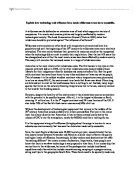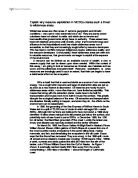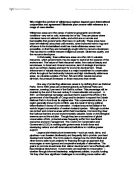However, despite the hostility of this environment it has always been seen as somewhere with the potential to be used by humans. After all, it is the largest wilderness on Earth, covering 14 million km2. It is the 5th largest continent and 58 times the size of the UK. It also holds 70% of the Earth’s fresh-water reserves and 90% of all ice.
Without the development of technological equipment that we saw in the middle of the 20th century Antarctica would probably still remain unmodified. The hole in the ozone layer lies almost directly over Antarctica. It has not been created locally but by the release of CFC’s into the atmosphere, mostly by MEDCs and this is melting the ice.
It is this equipment along with affluence (bringing about the surge in tourism to more adventurous environments) that has seen the Antarctica made really accessible.
Now, the most fragile wilderness sees 10,000 tourists per year, concentrated at the ice-free coastal zones between November and March as a direct result of better life quality and higher levels of affluence. Increasingly, holiday makers seek destinations that offer “something different” that create a sense of adventure. Importantly, these people now know that there is nowhere technology is not prepared to take them. It is a cruise ship that carries them to the wilderness, but some of the packages also include land-based expeditions and other activities include mountaineering, camping at a penguin colony, skiing and trips to the geographic South Pole. These boats need to be specially made and, although this type of tourism started in the late 1950’s, it is far easier now as the ice-strengthened material is cheap from Russia and technological resources carried on the ship make it safer and more attractive.
For sometime now, scientific researchers have been able to live on the continent. Research stations run by 18 countries operate all year round. During the Antarctic summer up to 5,000 research scientists and support staffs are based there. These numbers can increase as countries governments gain more affluence and can afford to put a larger amount of funding into the research. The scientist can get to the island by boat, helicopter or aeroplane now.
By far the biggest technological development is the road to the South Pole. It is made from the ice and crosses 1600 kilometres of treacherous terrain. The US has put $12 million dollars into the lengthy project, as well as many specialists and durable bulldozers and a snow tractor! They are one of the richest countries in the world and their wealth opens up a whole range of other technological possibilities in Antarctica after this project.
Despite this, Antarctica still remains, for the moment, largely undiscovered; people often refer to it as “the last wilderness”. As scarce resources elsewhere in the world become even scarcer, governments and businesses prefer to collect their resources from places where they are more obviously available. One example of this is the tropical rainforest.
Rainforests now cover less than 6% of Earth's land surface. Scientists estimate that more than half of all the world's plant and animal species live in tropical rain forests. Tropical rainforests produce 40% of Earth's oxygen.
Like the road to the Pole, under Avanca Brazil, various infrastructure elements are being created to help the development of areas of the Amazon rainforest. This project focuses on the building or paving of roads that will criss-cross the Amazon. These road networks will effectively fragment the most dense and remote areas of the Amazon Rainforest not only to create access to natural resources, but also allow for easier transportation routes between cities and ports close to the area.
Brazil is in a lot of debt. The World Bank has lent the government a lot of money to cover projects like the Grande Carajas Project in the south-eastern Brazilian Amazon region which is high in mineral, forestry, and hydroelectric resources. It was a project used to exploit the resources. Carajas included the construction of an open pit mine, a 890km railroad, and a port facility at Ponta de Madeira on the Amazon River so that the number of ships could increased ten-fold.
These are just two examples of how the affluence and technology of other countries and continents can affect a wilderness area. The Brazilian Government thinks that building these roads and pit mines will encourage international businesses to come and buy resources that their workmen have been able to obtain more easily. That way they can pay of some debt. The demand for goods such as timber, beef and palm oil from more affluent countries is what this country thrives on.
Traveling to the Solomon Islands is a more obvious choice for MEDC middle class tourists. It is hot with white sandy beaches and beautiful tropical rainforest covering most of it. Simple development of the rainforest and basic technology for Brazilian businesses like building places for the tourists to stay and ensuring they have access to clean water here is making this area of wilderness feel more accessible to a large amount of wealthy society.
To conclude, it seems inevitable that western countries are becoming increasingly more affluent and with this wealth comes better technology. As the above essay explains, technology leads to roads being built and transport increasing in the areas. Travel companies set up tourism schemes and resources start being extracted. These provide people with a lot of enjoyment, knowledge and more obviously, wealth.
However, it is important not to forget that the wildernesses are fragile once invaded by modern society and unless they are conserved in parts, the whole of a wilderness environment could become highly populated, deforested or simply destroyed. They cover nearly half the world’s land surface, so it is surely possible to sustain a large part of them whilst still being able to use our technological and economic advantages to gain the most out of them.







